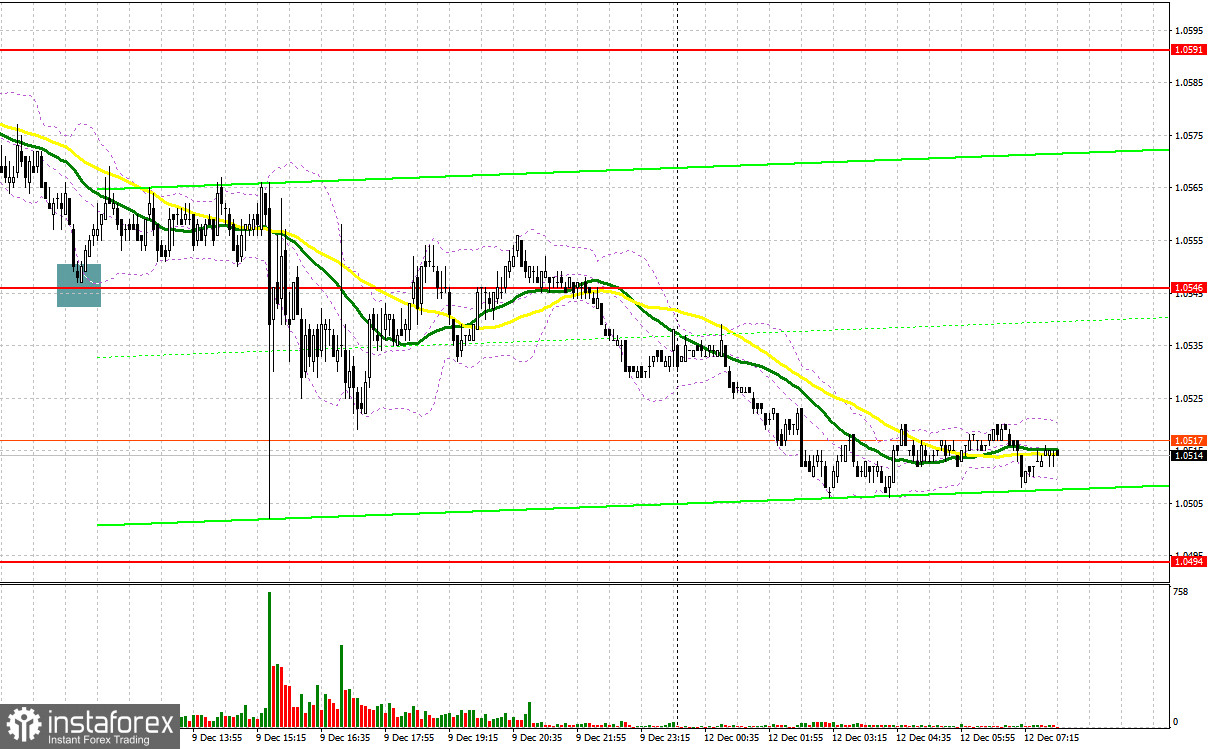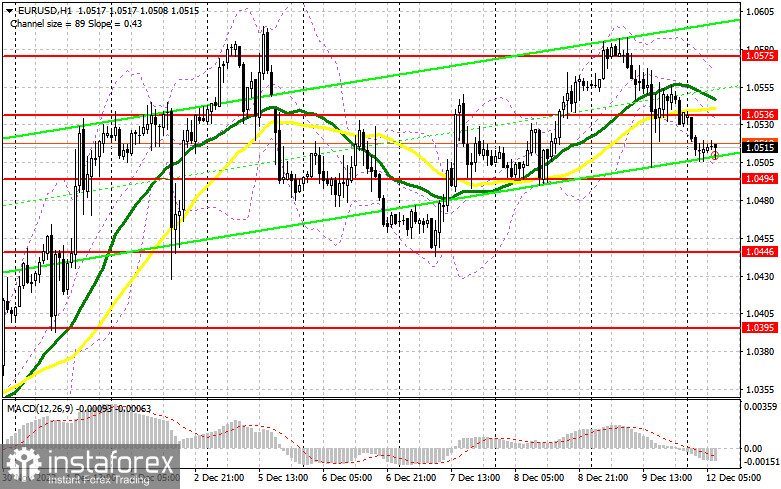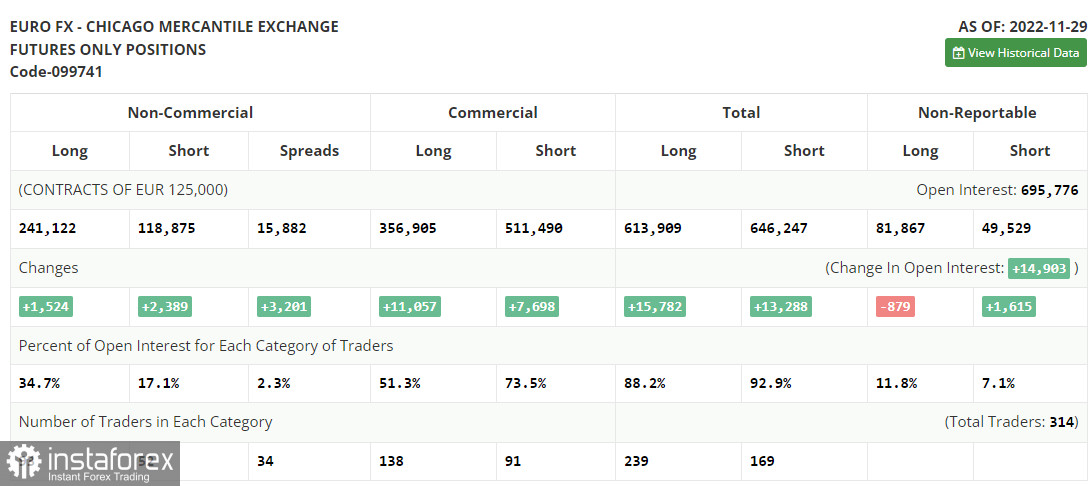Last Friday, treaders received just one signal to enter the market. Let us take a look at the 5-minute chart to figure out what happened. Earlier, I asked you to pay attention to the level of 1.0546 to decide when to enter the market. A decline and a false breakout of this level provided traders with a buy signal. As a result, the pair recovered by about 20 pips. However, it failed to hit the resistance level of 1.0591. In the second part of the day, there were no signals to enter the market. The fact is that the support level of 1.546 lost its force amid high volatility.

Conditions for opening long positions on EUR/USD:
On Friday, the US published its producer prices data, which boosted the US dollar. The fact is that inflationary pressure remained intact and may prevent the Fed from switching to a less hawkish stance this week. Today, the market is likely to take a pause ahead of the US consumer price index report. That is why today's volatility is unlikely to be high. A false breakout near the closest support level of 1.0494 will give a buy signal, allowing bulls to reach the middle of the sideways channel of 1.0536, formed on Friday. A breakout and a downward test of this area will give an additional long signal with the target at 1.0575. Notably, the price will hardly reach the monthly high today. Only a breakout of 1.0575 will affect bears' stop orders and form an additional signal to enter the market with the target of 1.0624, where it is recommended to lock in profits. If the euro/dollar pair declines and buyers fail to protect 1.0494, pressure on the pair will increase ahead of the publication of data from the US. In this case, the pair may start falling even more rapidly. A breakout of 1.0494 may push the pair toward the next support level of 1.0446. There, traders may open long positions only after a false breakout. Traders may also go long just after a bounce off 1.0395 or even lower – from 1.0346, expecting a rise of 30-35 pips within the day.
Conditions for opening short positions on EUR/USD:
Sellers are likely to remain cautious until the price drops below the low recorded last Friday. This will allow them to form a more considerable correction. Under the current conditions, it will be wise to go short after a false breakout of 1.0536. Slightly above this level, there are sellers' MAs. In this case, the pair may slide to the support level of 1.0494. The fact is that this level is also acting as a lower limit of the sideways channel. If bulls fail to protect this level, they may lose control over the market. A breakout and a test of this area will give an additional signal to sell the asset with the target at 1.0446. If the price settles below this level, it may slide to 1.0395. In the event of this, the likelihood of a bearish trend will become higher. Traders should lock in profits at this level. If the euro/dollar pair increases during the European session and bears fail to protect 1.0536, the price may jump to 1.0575. There, traders may also go short only after an unsuccessful settlement. It is also possible to sell the asset after a rebound from the high of 1.0624, expecting a decline of 30-35 pips.

COT report
According to the COT report from November 29, the number of both long and short positions increased. Announcements made by Jerome Powell last week retained demand for risk assets, including the euro. Since the pair has been confidently rising since November, there are a lot of traders who prefer selling at the current levels. Recent fundamental data from the US, namely, business activity and labor market indicators, allowed traders to bet on a longer period of higher interest rates in the US in the upcoming year. Against the backdrop, there is no good reason to open long positions in the mid term. The higher the euro climbs, the deeper it will fall. The week is expected to be calm and traders are likely to shift their attention to the FOMC meeting, which is scheduled for December 13-14. According to the COT report, the number of long non-commercial positions increased by 1,524 to 241,122, whereas the number of short non-commercial positions jumped by 2,389 to 118,875. At the end of the week, the total non-commercial net position decreased slightly to 122,234 from 123,112. This indicates that investors are no longer in such a hurry to buy back the euro since it is not as cheap as it was a few months earlier. The weekly closing price advanced to 1.0342 from 1.0315.

Signals of indicators:
Moving Averages
Trading is performed below 30- and 50-day moving averages, which reflect pressure on the euro.
Note: The period and prices of moving averages are considered by the author on the one-hour chart which differs from the general definition of the classic daily moving averages on the daily chart.
Bollinger Bands
If the pair advances, a resistance level could be seen at 1.0565, the upper limit of the indicator. In case of a decline, the lower limit of the indicator located at 1.0505 will act as support.
Description of indicators
- Moving average (moving average, determines the current trend by smoothing volatility and noise). The period is 50. It is marked in yellow on the chart.
- Moving average (moving average, determines the current trend by smoothing volatility and noise). The period is 30. It is marked in green on the graph.
- MACD indicator (Moving Average Convergence/Divergence - convergence/divergence of moving averages). A fast EMA period is 12. A slow EMA period is 26. The SMA period is 9.
- Bollinger Bands. The period is 20.
- Non-profit speculative traders are individual traders, hedge funds, and large institutions that use the futures market for speculative purposes and meet certain requirements.
- Long non-commercial positions are the total number of long positions opened by non-commercial traders.
- Short non-commercial positions are the total number of short positions opened by non-commercial traders.
- The total non-commercial net position is a difference in the number of short and long positions opened by non-commercial traders.
 English
English 
 Русский
Русский Bahasa Indonesia
Bahasa Indonesia Bahasa Malay
Bahasa Malay ไทย
ไทย Español
Español Deutsch
Deutsch Български
Български Français
Français Tiếng Việt
Tiếng Việt 中文
中文 বাংলা
বাংলা हिन्दी
हिन्दी Čeština
Čeština Українська
Українська Română
Română

